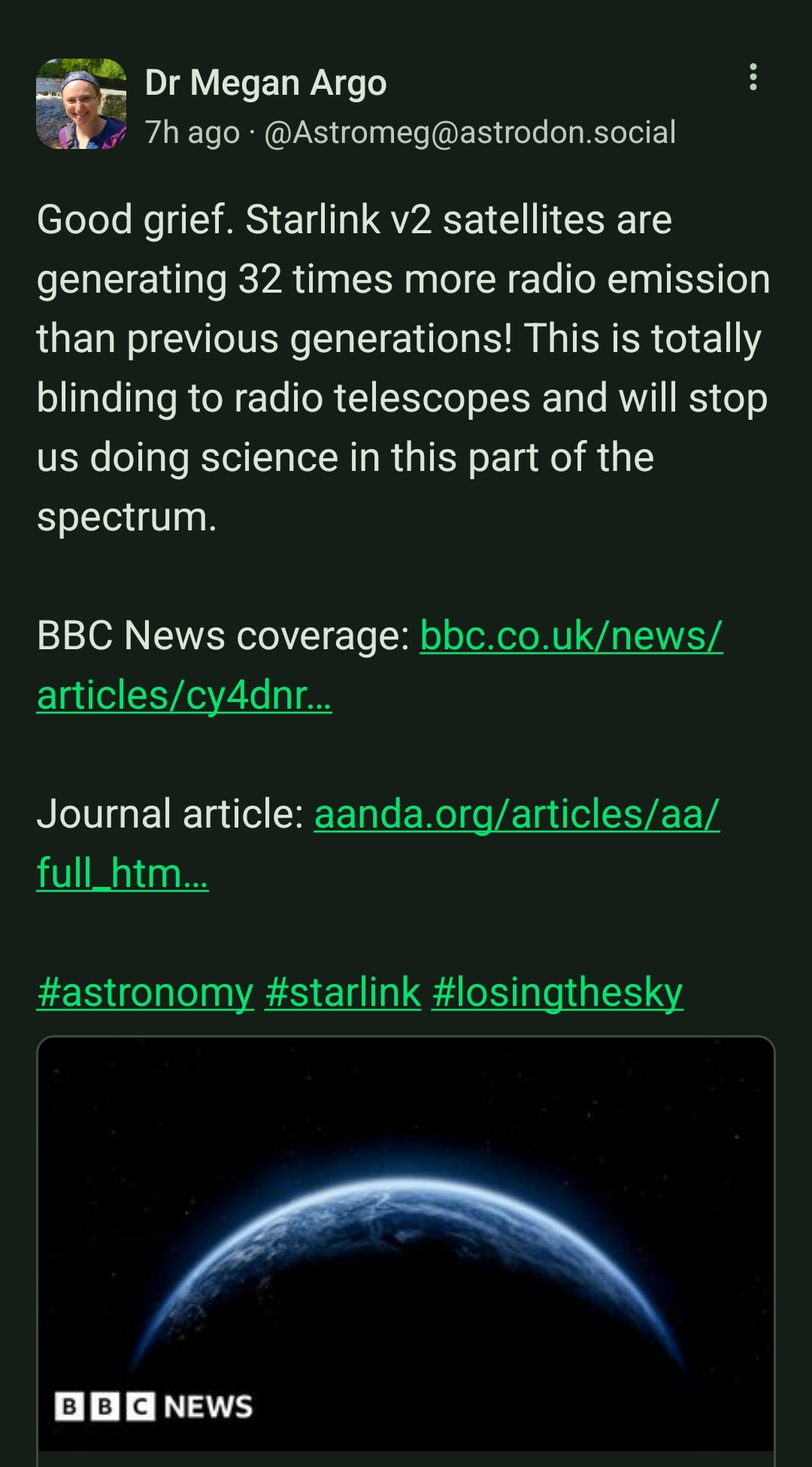this post was submitted on 18 Sep 2024
1216 points (97.5% liked)
Microblog Memes
5726 readers
1611 users here now
A place to share screenshots of Microblog posts, whether from Mastodon, tumblr, ~~Twitter~~ X, KBin, Threads or elsewhere.
Created as an evolution of White People Twitter and other tweet-capture subreddits.
Rules:
- Please put at least one word relevant to the post in the post title.
- Be nice.
- No advertising, brand promotion or guerilla marketing.
- Posters are encouraged to link to the toot or tweet etc in the description of posts.
Related communities:
founded 1 year ago
MODERATORS
you are viewing a single comment's thread
view the rest of the comments
view the rest of the comments

Is there any way to improve that? Or is it a hard limit due to physics?
The geosynchronous satellites are about ~~650~~ 65 times higher than Starlink satellites, so the speed of light is a significant limiting factor.
Geosynchronous orbit is 35,700 km (3.57 x 10^7 m) above sea level. At that distance, signals moving at the speed of light (3.0 x 10^8 m/s) take about .12 seconds to go that far. So a round trip is about .240 seconds or 240 milliseconds added to the ping.
Starlink orbits at an altitude of 550 km (5.5 x 10^5 m), where the signal can travel between ground and satellite in about 0.0018 seconds, for 3.6 millisecond round trip. Actual routing and processing of signals, especially relaying between satellites, adds time to the processing.
But no matter how much better the signal processing can get, the speed of light accounts for about a 200-230 millisecond difference at the difference in altitudes.
Thanks! That's the shit for which I come to Lemmy. Genuinely, thank you.
I work in broadcast communications and we use geosync link ups all the time for various shit. I'm pretty sure I know more about satellite communications than a normie, but I'm blind to the intricacies of use case when it comes to stuff like this.
Unfortunately it’s a hard limit due to the speed of light. Theoretically you could use quantum entanglement to get around it, but then of course you wouldn’t need the satellites anymore.
no, you couldn't. You can't use quantum entanglement to send information. Only random noise.
Sorry, I meant theoretically as in “at some distant point in the future where we’ve figured out how to make it work.” I probably read too much science fiction.
In real life, all quantum entanglement means is that you can entangle two particles, move them away from each other, and still know that when you measure one, the other will have the opposite value. It's akin to putting a red ball in one box and a blue ball in another, then muddling them up and posting them to two addresses. When opening one box, you instantly know that because you saw a red ball, the other recipient has a blue one or vice versa, but that's it. The extra quantum bit is just that the particles still do quantum things as if they're a maybe-red-maybe-blue superposition until they're measured. That's like having a sniffer dog at the post office that flags half of all things with red paint and a quarter of all things with blue paint as needing to be diverted to the police magically redirect three eighths of each colour instead of different amounts of the two colours. The balls didn't decide which was red and which was blue until the boxes were opened, but the choice always matches.
Science fiction quantum entanglement is not the same as real life quantum entanglement. Science fiction has spooky action at a distance, real life doesn't.
The speed of light is the speed of causality, the speed of information. It is physically impossible to send information at speeds greater than the speed of light.
it physically cannot work. ever. That's just how entanglement works. We know that much.
That's not true either unfortunately